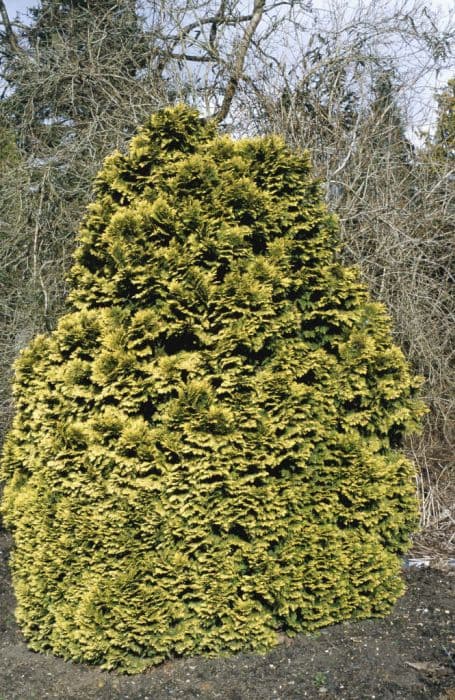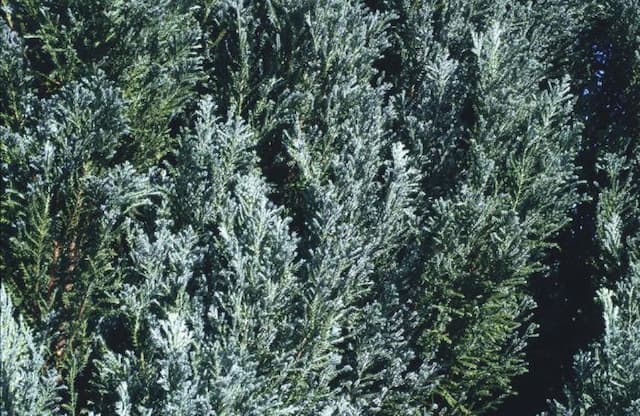Common Juniper Juniperus communis 'Green Carpet'

ABOUT
The 'Green Carpet' is a ground-covering evergreen that is a cultivar of the common juniper. It is naturally low to the ground and spreads horizontally, creating dense mats of foliage. The appearance of this plant is characterized by its rich green, needle-like leaves that are compact and tightly arranged on the branches, giving it a lush, carpet-like appearance. These needles are often soft to the touch when compared to other junipers, which can be more prickly. The plant maintains its attractive green color throughout the year, even in winter, adding year-round interest to the landscape. It produces small, hard, berry-like cones that are bluish or black with a waxy coating, but these are not usually prominent in its overall appearance.
About this plant
 Names
NamesFamily
Cupressaceae.
Synonyms
Common Juniper, Green Carpet Juniper.
Common names
Juniperus communis 'Green Carpet'.
 Toxicity
ToxicityTo humans
Common Juniper is generally not considered highly toxic to humans, but it can cause issues if ingested. Eating parts of this plant, particularly consuming the berries in large quantities, can lead to upset stomach, diarrhea, kidney damage, and other digestive issues due to its volatile oil content and potent compounds like thujone. Also, pregnant women should avoid consuming Common Juniper as it can stimulate the uterus and potentially cause miscarriages. Handling the plant might also lead to skin irritation in some individuals.
To pets
Common Juniper may also pose a risk to pets if ingested. Similar to humans, when pets consume parts of the plant, they might suffer from gastrointestinal upset, vomiting, diarrhea, or more serious issues like kidney or liver damage. As pet metabolism differs from humans, even a small amount might result in toxicity. If you suspect your pet has ingested Common Juniper, it is important to consult a veterinarian immediately.
 Characteristics
CharacteristicsLife cycle
Perennials
Foliage type
Evergreen
Color of leaves
Green
Height
6 inches (15 cm)
Spread
6 feet (1.8 meters)
Plant type
Shrub
Hardiness zones
3
Native area
Europe
Benefits
 General Benefits
General Benefits- Drought Tolerance: Juniperus communis 'Green Carpet' can survive with minimal water, once established, making it suitable for dry climates.
- Low Maintenance: It requires little maintenance beyond occasional trimming, thus saving time and effort for gardeners.
- Ground Cover: Its dense mat-like growth habit makes it an effective ground cover that inhibits weeds and stabilizes soil.
- Erosion Control: The plant's root system helps to prevent soil erosion, particularly on slopes and banks.
- Attracts Wildlife: Offers habitat and protection for wildlife such as birds and small mammals.
- Winter Interest: Provides greenery and maintains its color even in winter months, offering year-round visual interest.
- Adaptability: It's adaptable to a range of soil types, provided they are well-drained.
- Decorative Berries: Produces decorative berries that add aesthetic value to the landscape.
- Salt Tolerance: Shows resilience to salt, making it suitable for planting in coastal areas or near roads that are salted in winter.
 Medical Properties
Medical Properties- Antiseptic: Juniper berries have been used for their antiseptic properties to help treat urinary tract infections and cleanse the urinary system.
- Anti-inflammatory: The plant has been associated with reducing inflammation, especially in cases of arthritis and rheumatism.
- Antispasmodic: Juniper has been used to relieve muscle spasms.
- Diuretic: It is traditionally used as a diuretic, helping to remove excess water from the body and possibly aiding in conditions like edema.
- Carminative: Juniper may help to relieve gas and bloating by expelling gas from the stomach and intestines.
- Digestive stimulant: The berries have been used to stimulate the digestive system, potentially aiding in digestion and relieving indigestion.
 Air-purifying Qualities
Air-purifying QualitiesThis plant is not specifically known for air purifying qualities.
 Other Uses
Other Uses- Flavoring agent: Juniper berries from the Juniper plant are traditionally used to impart a distinct, sharp flavor to gin and various culinary dishes.
- Natural dye: The berries and foliage can be used to create natural dyes for fabrics and yarns, producing colors from green to yellow hues.
- Insect repellent: Juniper has been burned or used in oil form as a natural insect repellent, warding off mosquitoes and other pests.
- Closet freshener: Dried juniper branches can be placed in closets to impart their crisp fragrance and to help repel moths.
- Landscape design: 'Green Carpet' serves as a valuable ground cover with its dense mat-forming growth habit, providing aesthetic value in garden designs.
- Wildlife habitat: Juniper provides shelter and nesting sites for birds, as well as food in the form of its berries for various wildlife species.
- Fragrance production: The oil extracted from juniper berries is used in making perfumes and scented candles for its woodsy, pine-like scent.
- Bonsai cultivation: Some juniper varieties are popular choices for creating bonsai trees due to their adaptability and attractive growth patterns.
- Winter interest: In snowy landscapes, the evergreen nature of Juniper maintains a touch of green, adding visual interest during the colder months.
- Erosion control: The dense root system of ground cover junipers like 'Green Carpet' helps to prevent soil erosion on slopes and hillsides.
Interesting Facts
 Feng Shui
Feng ShuiJuniper is traditionally believed to have protective qualities, so placing a Juniper plant in the front of a house or by the entrance can create a barrier against negative energy. It can also cleanse the space of negativity and attract positive energy when placed in the east or southeast area of a garden or room.
 Zodiac Sign Compitability
Zodiac Sign CompitabilityThe Juniper plant is not used in astrology practice.
 Plant Symbolism
Plant Symbolism- Protection: Juniper has been used for its protective properties throughout history. It is believed to ward off evil spirits and negative energies.
- Cleansing: With its purifying scent, juniper is often associated with cleansing rituals and the purification of spaces and individuals.
- Healing: In various traditions, juniper is thought to have healing properties and is used in medicinal preparations to promote health and well-being.
- Longevity: The juniper tree is known for its long life; thus, it symbolizes longevity and the ability to withstand the test of time.
 Water
WaterGreen Carpet Juniper prefers evenly moist soil, especially during the first growing season, to establish a deep root system. Once established, it is fairly drought-tolerant. Water this ground cover once a week with about 1 to 1.5 gallons for each plant, depending on the soil type and weather conditions. In hotter, drier weather, increase watering frequency to twice a week. During fall and winter, reduce watering to every other week if there is no significant rainfall.
 Light
LightThe Green Carpet Juniper thrives in full sunlight and performs best when it receives at least six hours of unfiltered sunlight each day. It can tolerate partial shade but its growth may be less dense. The ideal spot for planting is an area with clear exposure to the sky, away from taller trees or structures that could block sun.
 Temperature
TemperatureGreen Carpet Juniper is a hardy plant that can tolerate a range of temperatures, and does best in temperatures between 40 to 85 degrees Fahrenheit. It can survive minimum winter temperatures down to -30 degrees Fahrenheit and maximum summer temperatures up to 90 degrees Fahrenheit, making it suitable for many climates.
 Pruning
PruningPrune the Green Carpet Juniper to maintain its shape and remove any damaged or diseased branches. Pruning is best done in the late winter or early spring before new growth starts. This juniper variety generally requires minimal pruning, and it can be done annually or as needed to keep the desired form.
 Cleaning
CleaningNot needed
 Soil
SoilThe Common Juniper 'Green Carpet' thrives in well-draining soil with a mix of sand, loam, and organic matter. A slightly acidic to neutral pH of 6.0 to 7.0 is ideal for this cultivar.
 Repotting
RepottingCommon Juniper 'Green Carpet' generally does not require frequent repotting. It can be repotted every 3-5 years or as needed when it outgrows its container.
 Humidity & Misting
Humidity & MistingCommon Juniper 'Green Carpet' is tolerant of a range of humidity levels and does well in average outdoor conditions; it does not require high humidity.
 Suitable locations
Suitable locationsIndoor
Ensure full sun, good air circulation, and avoid overwatering.
Outdoor
Place in full sun, well-draining soil, and shelter from harsh winds.
Hardiness zone
2-6 USDA
 Life cycle
Life cycleJuniperus communis 'Green Carpet', commonly known as Common Juniper, begins its life as a seed, which requires a period of stratification to break dormancy. Upon germination, a seedling is produced, which establishes roots and a low-growing stem. As a juvenile, the plant grows slowly, developing dense foliage and a sprawling, mat-forming habit that characterizes the 'Green Carpet' cultivar. It reaches maturity in several years and starts producing cones; male plants bearing pollen and female plants developing berry-like cones called juniper berries. The plant is long-lived, and once mature, it will continue to produce cones annually, capable of withstanding a range of environmental conditions. Throughout its life, which can last for decades, the 'Green Carpet' requires little maintenance, tolerating poor soils and drought while spreading horizontally across the ground.
 Propogation
PropogationPropogation time
Late Winter to Early Spring
The most popular method for propagating Juniperus communis 'Green Carpet', more commonly known as the common juniper, is through cuttings. This is often done in late summer. Semi-hardwood cuttings are taken from the current year's growth, ensuring each cutting is about 4 to 6 inches (10 to 15 cm) long. The bottom inch (2.54 cm) of the cutting is stripped of needles, dipped in rooting hormone, and then inserted into a mix of equal parts peat and perlite. The cuttings are then kept under high humidity and indirect light until roots develop, which may take several weeks. During this time, it's crucial to keep the soil mix moist but not waterlogged, facilitating the rooting process without causing rot.









